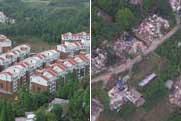China
FAO: Sichuan earthquake caused $6-bln damage to agriculture
Source: Xinhua | 07-01-2008 10:48
Special Report: Strong quake jolts SW ChinaROME, June 30 (Xinhua) -- The agricultural sector in China's Sichuan province has suffered enormous damage, estimated at around 6 billion U.S. dollars, as a result of last month's devastating earthquake, the UN Food and Agriculture Organization (FAO) said Monday.
According to a FAO assessment mission that recently visited Sichuan province, over 30 million people in rural communities have been severely hit and lost most of their assets. Thousands of hectares of farmlands were destroyed, millions of farm animals were killed, houses and grain stores collapsed and thousands of pieces of agricultural machinery were damaged.
"In addition to the human tragedy caused by the disaster - mainly the loss of family members - many rural communities in Sichuan province have lost their means to produce food and create income," said Rajendra Aryal, FAO Senior Regional Emergency Coordinator.
"People in the villages have demonstrated great resilience and have expressed their strong willingness to return to their fields and resume farming and food production. It will probably take three to five years to rebuild the agricultural sector in Sichuan," Aryal added.
A significant portion of wheat crops could not be harvested after the earthquake due to the lack of labor, as a result of deaths and injuries in farming families. Much of the wheat that was harvested before the earthquake - around 350,000 tonnes in Mianyang Prefecture (one of the areas hit by the quake) - was damaged with the collapse of grain storage facilities.
The current shortages of pesticides and fertilizers are also jeopardizing future food production, the FAO said.
In addition, thousands of greenhouses have collapsed causing severe losses of vegetable crops. Major seed growing areas in the province, producing up to 20 percent of China's rice seeds, have been badly hit by the earthquake with more than 20,000 hectares affected, the FAO said.
Rice fields have dried up due to cracks and craters, and irrigation systems have been interrupted. In some villages, up to 70 percent of rice fields have been damaged. The next harvest could face a shortfall between 10 and 50 percent, due to delayed planting, pests and water shortages, according to the FAO.
Over 3 million pigs have been killed by the earthquake, with some villages having lost up to 70 percent of their livestock. Overall livestock losses are estimated at about 2 billion dollars.
"The urgent provision of fertilizers, pesticides, farm tools and machinery, livestock and reclaiming damaged fields will be the main challenge for the next six months," Aryal said.
The medium and long-term relief efforts will have to focus on the rehabilitation of water reservoirs, dams, animal shelters, the training of farmers in cash-crop production and disaster preparedness. Also, the bureau of agriculture in each county needs support to rehabilitate damaged infrastructure, office equipment, seed inspection and testing facilities, warehouses and technical extension services.
The Chinese authorities have asked the FAO to coordinate the agricultural rehabilitation efforts in Sichuan province.
Editor:Xiong Qu



